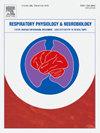Complex respiratory effects of nebulised citric acid and capsaicin as tussive agents: A comparative study in conventional and specific pathogen-free guinea pigs
IF 1.6
4区 医学
Q3 PHYSIOLOGY
引用次数: 0
Abstract
Background
Citric acid and capsaicin are commonly used in cough research due to their reproducible effects on animal models and humans. However, these extend beyond cough provocation.
Objective
To characterize and describe the respiratory responses to citric acid and capsaicin exposure using whole-body plethysmography in conventional (CON) and specific pathogen-free (SPF) guinea pigs.
Methods
Male and female guinea pigs were exposed to aerosols of saline, citric acid (0.4 M), and capsaicin (25 µM). Cough and respiratory parameters (inspiratory and expiratory time, respiratory rate, tidal volume, enhanced pause and mid-expiratory flow) were recorded.
Results
Both tussive agents induced upper and lower airway responses besides cough, with significant differences in respiratory parameters between CON and SPF animals. Citric acid elicited a stronger upper airway response compared to capsaicin.
Conclusion
Citric acid and capsaicin trigger complex respiratory responses (bronchoconstriction, braking, breathing pattern changes). These findings highlight the need to consider broader respiratory responses in translational cough research.
雾化柠檬酸和辣椒素作为咳嗽剂的复杂呼吸效应:在常规和特定无病原体豚鼠中的比较研究
背景:柠檬酸和辣椒素在咳嗽研究中被广泛使用,因为它们对动物模型和人类具有可重复性的影响。然而,这些不仅仅是咳嗽引起的。目的用全身容积描记法描述常规(CON)和无特异性病原体(SPF)豚鼠对柠檬酸和辣椒素暴露的呼吸反应。方法将雄性和雌性豚鼠分别暴露于生理盐水、柠檬酸(0.4 M)和辣椒素(25 µM)的气溶胶中。记录咳嗽和呼吸参数(吸气和呼气时间、呼吸频率、潮气量、增强暂停和呼气中流量)。结果除咳嗽外,两种吸咳剂均可引起上呼吸道和下呼吸道反应,CON和SPF动物的呼吸参数有显著差异。与辣椒素相比,柠檬酸引起更强的上呼吸道反应。结论柠檬酸和辣椒素可引发复杂的呼吸反应(支气管收缩、制动、呼吸模式改变)。这些发现强调了在转译咳嗽研究中考虑更广泛的呼吸反应的必要性。
本文章由计算机程序翻译,如有差异,请以英文原文为准。
求助全文
约1分钟内获得全文
求助全文
来源期刊
CiteScore
4.80
自引率
8.70%
发文量
104
审稿时长
54 days
期刊介绍:
Respiratory Physiology & Neurobiology (RESPNB) publishes original articles and invited reviews concerning physiology and pathophysiology of respiration in its broadest sense.
Although a special focus is on topics in neurobiology, high quality papers in respiratory molecular and cellular biology are also welcome, as are high-quality papers in traditional areas, such as:
-Mechanics of breathing-
Gas exchange and acid-base balance-
Respiration at rest and exercise-
Respiration in unusual conditions, like high or low pressure or changes of temperature, low ambient oxygen-
Embryonic and adult respiration-
Comparative respiratory physiology.
Papers on clinical aspects, original methods, as well as theoretical papers are also considered as long as they foster the understanding of respiratory physiology and pathophysiology.

 求助内容:
求助内容: 应助结果提醒方式:
应助结果提醒方式:


